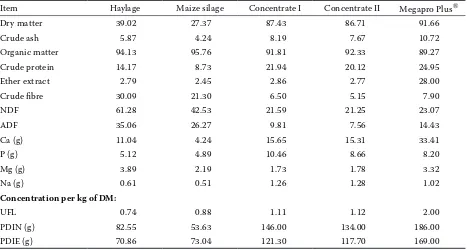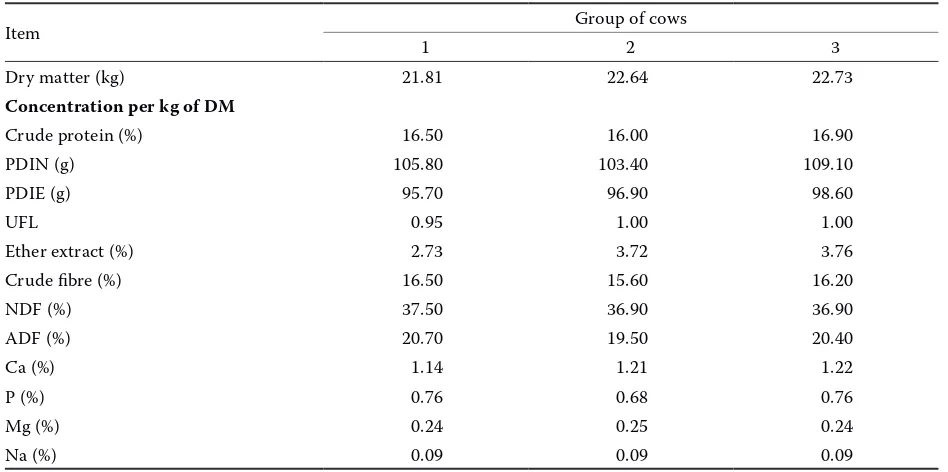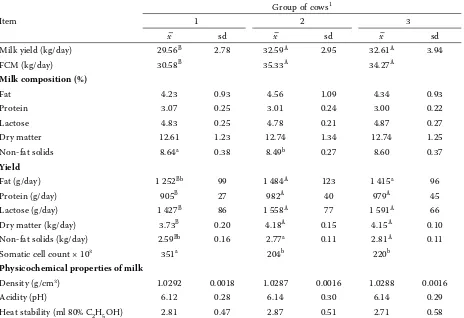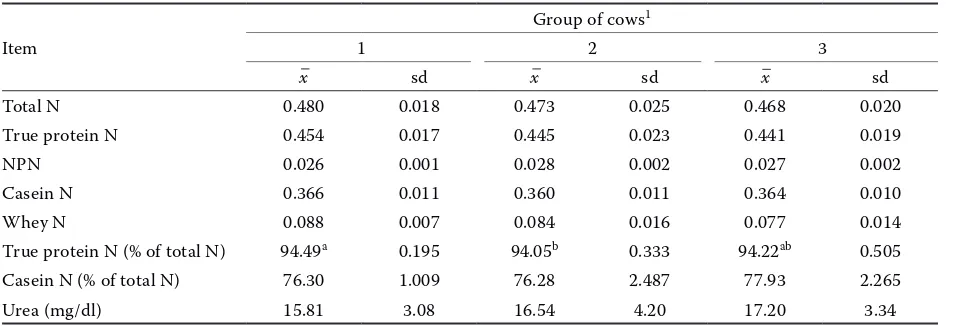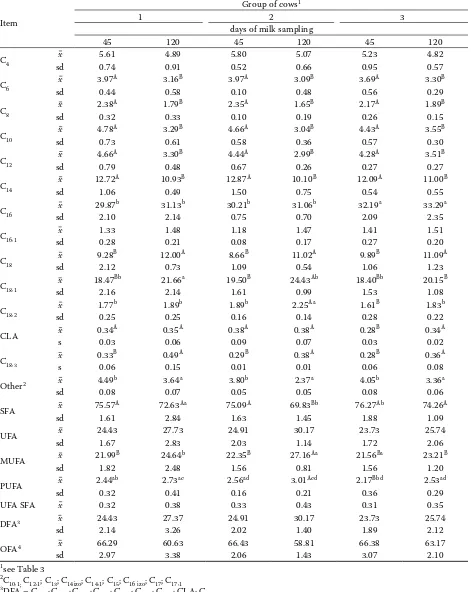Traditional sources of energy and protein are used most frequently in order to improve the nu-tritive value of diets for high-performance cows. Energy deficiency in the ration as well as exces-sive supply of rumen degradable protein can reduce milk yield and negatively effect milk composition (Colin–Schoellen et al., 1995; Kowalski, 1997). Therefore the sources of digestible energy such as calcium salts of fatty acids (CaFA), containing ru-men undegradable protein, may be a viable alterna-tive to starch since they meet nutrient requirements of high-production cows at the peak of lactation (Kellaway and Porter, 1993; Wu and Huber, 1994; Brzóska et al., 1999a; Bolland et al., 2001; Bargo et al., 2003; Schroeder et al., 2002, 2004). In addi-tion, protein protected with calcium salts of fatty acids effectively increases the supply of intestine-absorbed protein in cows fed high-energy diets
(Kowalski, 1997). In addition, fat supplements containing rumen-protected protein modify the composition of milk fatty acids, thus improving the health properties of milk (Brzóska et al., 1999a; Brzóska and Kowalczyk, 2002; Jensen, 2002; Ward et al., 2002). The effectiveness of fat supplements or their derivatives containing rumen undegradable protein is relatively high (Jenkins, 1993; Bolland et al., 2001; Pieszka and Brzóska, 2001) and related, among others, to the type and concentration of fat in the diet (Sklan et al., 1991, 1992; Brzóska et al.,
1999a; Drackley et al., 2001). This is the reason why the addition of supplements in which the protein from high-protein components is protected with calcium salts of fatty acids to the diet for high-performance cows is of significant importance. An example of such a feed additive may be the energy-protein supplement Megapro Plus®.
Effects of fat-protein supplementation of diets for cows
in early lactation on milk yield and composition
D. Strusińska, D. Minakowski, B. Pysera, J. Kaliniewicz
Department of Animal Nutrition and Feed Management, University of Warmia and Mazuria, Olsztyn, Poland
ABSTRACT: An experiment was performed on 37 Holstein-Friesian cows during the first 120 days of lactation. The cows were fed balanced diets composed of haylage and maize silage (together 52% dry mater) and a concen-trate containing 19% crude protein (group 1), a concenconcen-trate containing 17.5% crude protein and 1 kg of fat-protein
supplement Megapro Plus® (group 2) or a concentrate containing 19% crude protein and 1 kg of fat-protein
sup-plement Megapro Plus® (group 3). The mean daily milk yield recorded in groups 2 and 3 amounted to 32.6 kg/d
and was by 10.3% higher than in the control group (P ≤ 0.01). FCM yield increased by 15.5% and 12.1% in groups 2
and 3, respectively, in comparison with group 1. Diet supplementation with Megapro Plus® had no significant
effect on the levels of fat, lactose, protein, nitrogen fractions and urea, or some physicochemical properties of milk (density, pH, heat stability). A decrease was noted in solids-non-fat (group 2) and somatic cell count (P ≤ 0.05). Megapro Plus® supplementation of a diet with a reduced (to 3%) “00” rapeseed meal content in concentrate (group 2) resulted in a significant increase in the concentrations of unsaturated fatty acids (especially C18:1 and C18:2) and
hypocholesterolaemic acids (DFA) in milk, recorded on the 120th day of lactation. Megapro Plus®
supplementa-tion of a concentrate with a high (10%) “00” rapeseed meal content aimed at increasing the concentrasupplementa-tions of both energy and protein (group 3), had no significant effect on improvement in the fatty acid profile, i.e. changes towards increasing unsaturation of milk fat.
The objective of the present study was to deter-mine the effects of energy-protein supplementation (Megapro Plus®) of winter diets fed to high-per-formance cows on the yield, composition and some physicochemical properties of milk at the initial stage of lactation.
MATERIAL AND METHODS
Animals and feeding system
An experiment was performed on 37 Holstein-Friesian cows with mean body weights of 640 kg (±42 kg), assigned to three groups by the analogue method, taking into account date of calving, lacta-tion (third or fourth), and milk yield in the previous lactation. The cows were fed balanced diets accord-ing to INRA standards (1997). The ration was com-posed of haylage (15 kg) and 20 kg of maize silage (together 52% dry mater), and a feed mixture with a varying crude protein content. Group 1 (control – 12 head) received roughage and concentrate (I) containing 19% crude protein (128 g PDIN, 106 g PDIE, 0.97 UFL). Group 2 (experimental – 13 head) was fed roughage and concentrate (II) containing 17.5% crude protein (116 g PDIN, 102 g PDIE, 0.97 UFL), and 1 kg of fat-protein supplement (Megapro Plus®, Agro-Best, Czech Republic). Group
3 (experimental –12 head) received roughage and
concentrate (I) containing 19% crude protein (as in group 1), and 1 kg of fat-protein supplement
(Megapro Plus®). The components of
concentra-te fed to groups 1 and 3 were as follows: proconcentra-tein- protein-based concentrate (30%), “00” rapeseed meal (10%), ground grain, wheat bran (58%) and mineral sup-plements (2%). In order to decrease the crude pro-tein concentration in a concentrate for group 2, rapeseed meal content was reduced to 3%.
The supplement Megapro Plus® contains calcium
[image:2.595.306.533.104.254.2]salt of palm oil fatty acids, “00” rapeseed meal and
Table 1. Fatty acid composition of Megapro Plus® fat
Fatty acids g/100 g Fatty acids g/100 g
C12 0.63 others1 0.93
C14 1.32 SFA 51.61
C16 45.24 UFA 48.39
C18 4.12 MUFA 36.92
C18:1 36.06 PUFA 11.47
C18:2 10.24 DFA2 48.39
C18:3 1.23 OFA3 47.49
C20 0.23
1C
15 – 0.07; C16:1 – 0.68; C20:1 – 0.18 2DFA – C
16:1; C18:1; C18:2; C18:3;C20:1 3OFA – C
12;C14; C15; C16; C20;C22
C18 – neutral FA
Table 2. Chemical composition and feeding value of feeds (% DM)
Item Haylage Maize silage Concentrate I Concentrate II Megapro Plus®
Dry matter 39.02 27.37 87.43 86.71 91.66
Crude ash 5.87 4.24 8.19 7.67 10.72
Organic matter 94.13 95.76 91.81 92.33 89.27
Crude protein 14.17 8.73 21.94 20.12 24.95
Ether extract 2.79 2.45 2.86 2.77 28.00
Crude fibre 30.09 21.30 6.50 5.15 7.90
NDF 61.28 42.53 21.59 21.25 23.07
ADF 35.06 26.27 9.81 7.56 14.43
Ca (g) 11.04 4.24 15.65 15.31 33.41
P (g) 5.12 4.89 10.46 8.66 8.20
Mg (g) 3.89 2.19 1.73 1.78 3.32
Na (g) 0.61 0.51 1.26 1.28 1.02
Concentration per kg ofDM:
UFL 0.74 0.88 1.11 1.12 2.00
PDIN (g) 82.55 53.63 146.00 134.00 186.00
[image:2.595.64.531.508.758.2]molasses. The nutritive value per kg of supplement is 2.00 UFL, 250 g crude protein, 186 g PDIN and 169 g PDIE. The fatty acid composition of Megapro Plus is given in Table 1. The supplement was ap-plied twice a day (0.5 kg/head) with the concentrate, for the first 120 days of lactation.
The chemical composition and nutritive value of diets and Megapro Plus are given in Table 2.
Chemical analyses
Feed samples were taken once a month to deter-mine the composition of basic nutrients (AOAC, 1990), fractions of acid detergent fibre (ADF) and neutral detergent fibre (NDF) by the Goering and Van Soest method (1970) in a Tecator Fibertec M system. Mineral components were determined us-ing a Flapho-4 flame photometer (Ca and Na) or by atomic absorption spectrophotometry (ASA) (Mg and P).
Milk yield was recorded every 15 days. The levels of major components, urea and somatic cell count (SCC) were assessed in milk samples using a Combi Foss apparatus. The levels of total nitrogen, non-protein nitrogen – NPN (following 15% trichloro-acetic acid precipitation) and non-casein nitrogen (following 10% acetic acid and 1 M sodium acetate
precipitation) were determined by the Kjedahl procedure. Casein nitrogen was calculated as the difference between total nitrogen and non-casein nitrogen whereas true protein nitrogen was deter-mined as the difference between total protein nitro-gen and non-protein nitronitro-gen (NPN). Milk density was determined with lactodensimeter, acidity with pH-meter (model CP-315), and heat stability (ml of
80% C2H5COOH) by the methods described by
Budsławski (1973).
In milk samples collected on the 45th and 120th day of lactation, milk fatty acids were separated by gas chromatography (PU-4 600 chromatograph, flame-ionization detector FID, capillary column, 30 m × 0.32 mm i.o. × 0.25 μm film, detector tem-perature 250°C, column temtem-perature 170°C, sample dosing – split/50:1, carrier gas – helium).
Statistical analysis
[image:3.595.62.536.477.713.2]The results were analyzed statistically by an ana-lys of variance (Anova/Manova) in a two-factor non-orthogonal design (groups of animals, sam-pling periods). The significance of differences between the experimental factors was determi-ned by Duncan’s test, using Statistica 6.0 PL soft-ware.
Table 3. Nutritive value of the rations for dairy cows
Item Group of cows
1 2 3
Dry matter (kg) 21.81 22.64 22.73
Concentration per kg of DM
Crude protein (%) 16.50 16.00 16.90
PDIN (g) 105.80 103.40 109.10
PDIE (g) 95.70 96.90 98.60
UFL 0.95 1.00 1.00
Ether extract (%) 2.73 3.72 3.76
Crude fibre (%) 16.50 15.60 16.20
NDF (%) 37.50 36.90 36.90
ADF (%) 20.70 19.50 20.40
Ca (%) 1.14 1.21 1.22
P (%) 0.76 0.68 0.76
Mg (%) 0.24 0.25 0.24
Na (%) 0.09 0.09 0.09
1 – control
2 – ration with increased energy concentration
RESuLTS AND DISCuSSION
Diet enrichment with the fat-protein supplement Megapro Plus® resulted in a 5.3% increase in dry
matter energy concentration (1.00 vs. 0.95 UFL). Group 3 cows, compared with those of group 2 and 1, received a diet with an increased concentration of crude protein, by 5.6% and 2.4% respectively (Table 3). It should be emphasized that the sup-plement Megapro Plus® had no negative effect on
the amount of DM of roughage (silage) taken in by cows over the experimental period.
During the first 120 days of lactation, the mean daily milk yield recorded in cows fed a diet supple-mented with Megapro Plus® was by 3.03 kg (group 2)
and 3.05 kg (group 3) higher than in the control group (increase by 10.3%, P ≤ 0.01). FCM yield (Table 4) increased by 15.5% and 12.1%, respec-tively, in comparison with group 1 (P ≤ 0.01). A
higher dry matter energy concentration in the diet for group 2 allowed to increase milk fat content by 7.8% (4.23 vs. 4.56%), but it was accompanied by a slight decrease in the levels of milk protein (3.07 vs. 3.01%) and solids-non-fat (P ≤ 0.05), as compared with group 1 (control). The feeding of high levels of supplemental energy and protein in dairy cow diet (group 3) was characterized by slightly higher concentrations of fat (by 2.6%) and dry matter, and a lower protein level (by approx. 2%), in comparison with group 1 (statistically non-significant differ-ences). Due to higher milk production in group 1 and 2, mean daily yields of major milk components were highly significantly or significantly higher than their yields recorded in the control group (Table 4). The slight decrease in the protein content of milk from cows fed a diet supplemented with Megapro Plus®concerned primarily the nitrogen fraction of
[image:4.595.68.532.365.683.2]true protein (groups 2 and 3) and whey protein
Table 4. Milk yield, composition and physicochemical properties of milk*
Item
Group of cows1
1 2 3
x sd x sd x sd
Milk yield (kg/day) 29.56B 2.78 32.59A 2.95 32.61A 3.94
FCM (kg/day) 30.58B 35.33A 34.27A
Milk composition (%)
Fat 4.23 0.93 4.56 1.09 4.34 0.93
Protein 3.07 0.25 3.01 0.24 3.00 0.22
Lactose 4.83 0.25 4.78 0.21 4.87 0.27
Dry matter 12.61 1.23 12.74 1.34 12.74 1.25
Non-fat solids 8.64a 0.38 8.49b 0.27 8.60 0.37
Yield
Fat (g/day) 1 252Bb 99 1 484A 123 1 415a 96
Protein (g/day) 905B 27 982A 40 979A 45
Lactose (g/day) 1 427B 86 1 558A 77 1 591A 66
Dry matter (kg/day) 3.73B 0.20 4.18A 0.15 4.15A 0.10
Non-fat solids (kg/day) 2.59Bb 0.16 2.77a 0.11 2.81A 0.11
Somatic cell count × 103 351a 204b 220b
Physicochemical properties of milk
Density (g/cm3) 1.0292 0.0018 1.0287 0.0016 1.0288 0.0016
Acidity (pH) 6.12 0.28 6.14 0.30 6.14 0.29
Heat stability (ml 80% C2H5OH) 2.81 0.47 2.87 0.51 2.71 0.58
1see Table 3
mean daily values on days 1–120 of lactation; sd = standard deviation FCM – milk corrected for 4% of fat
(group 3). No considerable changes were observed in casein nitrogen and non-protein nitrogen (NPN). The proportion of the nitrogen fraction of true protein in total nitrogen decreased as well, from 94.49% to 94.05% and 94.22% in group 2 (P ≤ 0.05) and 3, respectively (Table 5). Results of other stud-ies indicated a positive effect of diet supplementa-tion with calcium salts of fatty acids (CaFA) on milk yield and composition, especially at the peak of lactation (Doreau et al., 1993; Cervantes et al., 1996; Kowalski, 1997; Schroeder et al., 2004). According to Kraszewski et al. (2003), diet enrichment with the fat-protein supplement Megapro (during the first 100 days of lactation) enabled to increase daily milk yield by 3.02 kg (34.77 vs. 31.75 kg), and levels of fat (by 0.41 percentage unit) and protein (by 0.05 percentage unit). They also reported a decrease in somatic cell count, with no changes in milk acid-ity and densacid-ity. Pieszka and Brzóska (2001) found that rapeseed meal and soybean meal protection by calcium salts of fatty acids during winter feeding of cows at the first stage of lactation resulted in a significant increase in FCM yield, by 2.1 kg and 2.3 kg/day respectively, and milk fat yield, by 118 and 114 g/day. They also observed a slight decrease in milk protein content, especially true protein and casein nitrogen protein fractions (non-significant differences). Other authors (Doreau et al., 1993; Cervantes et al., 1996; Kowalski, 1997; Brzóska et al., 1999b; Brzóska and Kowalczyk, 2002; Schroeder et al., 2004) also confirmed the fact that diets sup-plemented with fat (including CaFA), regardless of its source, usually reduced milk protein content,
[image:5.595.62.542.101.264.2]but di not decrease protein yield. According to Wu and Huber (1994), an increase in dietary fat con-tent from 2.5 to 8% dry matter was accompanied by a decrease in milk protein content, on average by 3.8%. The slight decrease in milk protein con-tent observed in our study could be a consequence of the deficiency of amino acids indispensable for protein synthesis in the mammary gland, with in-creased biosynthesis of milk components due to the higher dietary energy supply, as reported also by other authors (Cant et al., 1993; Wu and Huber, 1994; Antoniewicz et al., 1996; Schingoethe, 1996; Kowalski et al., 1999). The lower protein milk level may also be related to a decrease in the levels of available glucose and blood plasma insulin, and reduced insulin efficiency in cows fed fat-supple-mented diets (Antoniewicz et al., 1996). The in-creased milk fat concentration could result from the direct use of long-chain fatty acids from feed for milk lipid synthesis in the mammary gland, thus reducing energy expenditures for milk lipid fraction formation (Palmquist et al., 1993). Many authors (Simas et al., 1995; Cervantes et al., 1996; Kowalski, 1997; Pieszka and Brzóska, 2001) pointed to the fact that the fat content of milk from cows given fat-supplemented diets was differentiated. A decrease in milk fat concentration following diet supplemen-tation with plant oils or fish oils, and an increase in fat content or its unchanged level following the protected fat supply were observed quite frequently (Sklan et al., 1992; Cervantes et al., 1996; Doreau and Chilliard, 1996; Elliott et al., 1996; Brzóska et al., 1999b; Brzóska and Kowalczyk, 2002).
Table 5. Nitrogen fraction and urea content in milk (%)
Item
Group of cows1
1 2 3
x sd x sd x sd
Total N 0.480 0.018 0.473 0.025 0.468 0.020
True protein N 0.454 0.017 0.445 0.023 0.441 0.019
NPN 0.026 0.001 0.028 0.002 0.027 0.002
Casein N 0.366 0.011 0.360 0.011 0.364 0.010
Whey N 0.088 0.007 0.084 0.016 0.077 0.014
True protein N (% of total N) 94.49a 0.195 94.05b 0.333 94.22ab 0.505
Casein N (% of total N) 76.30 1.009 76.28 2.487 77.93 2.265
Urea (mg/dl) 15.81 3.08 16.54 4.20 17.20 3.34
1see Table 3
sd = standard deviation
Table 6. Fatty acid composition of milk fat (g/100 g total fatty acids)
Item
Group of cows1
1 2 3
days of milk sampling
45 120 45 120 45 120
C4 x 5.61 4.89 5.80 5.07 5.23 4.82
sd 0.74 0.91 0.52 0.66 0.95 0.57
C6 sdx 3.970.44A 3.160.58B 3.970.10A 3.090.48B 3.690.56A 3.300.29B
C8 x 2.38
A 1.79B 2.35A 1.65B 2.17A 1.89B
sd 0.32 0.33 0.10 0.19 0.26 0.15
C10 x 4.78A 3.29B 4.66A 3.04B 4.43A 3.55B
sd 0.73 0.61 0.58 0.36 0.57 0.30
C12 x 4.66
A 3.30B 4.44A 2.99B 4.28A 3.51B
sd 0.79 0.48 0.67 0.26 0.27 0.27
C14 x 12.72A 10.93B 12.87A 10.10B 12.09A 11.00B
sd 1.06 0.49 1.50 0.75 0.54 0.55
C16 sdx 29.872.10b 31.132.14b 30.210.75b 31.060.70b 32.192.09a 33.292.35a
C16:1 sdx 1.330.28 1.480.21 1.180.08 1.470.17 1.410.27 1.510.20
C18 x 9.28B 12.00A 8.66B 11.02A 9.89B 11.09A
sd 2.12 0.73 1.09 0.54 1.06 1.23
C18:1 x 18.47
Bb 21.66a 19.50B 24.43Ab 18.40Bb 20.15B
sd 2.16 2.14 1.61 0.99 1.53 1.08
C18:2 x 1.77b 1.89b 1.89b 2.25Aa 1.61B 1.83b
sd 0.25 0.25 0.16 0.14 0.28 0.22
CLA xs 0.340.03A 0.350.06A 0.380.09A 0.380.07A 0.280.03B 0.340.02A
C18:3 x 0.33
B 0.49A 0.29B 0.38A 0.28B 0.36A
s 0.06 0.15 0.01 0.01 0.06 0.08
Other2 x 4.49b 3.64a 3.80b 2.37a 4.05b 3.36a
sd 0.08 0.07 0.05 0.05 0.08 0.06
SFA sdx 75.571.61A 72.632.84Aa 75.091.63A 69.831.45Bb 76.271.88Ab 74.261.09A
UFA sdx 24.431.67 27.732.83 24.912.03 30.171.14 23.731.72 25.742.06
MUFA x 21.99B 24.64b 22.35B 27.16Aa 21.56Ba 23.21B
sd 1.82 2.48 1.56 0.81 1.56 1.20
PUFA sdx 2.440.32ab 2.730.41ac 2.560.16ad 3.010.21Acd 2.170.36Bbd 2.530.29ad
UFA SFA x 0.32 0.38 0.33 0.43 0.31 0.35
DFA3 x 24.43 27.37 24.91 30.17 23.73 25.74
sd 2.14 3.26 2.02 1.40 1.89 2.12
OFA4 x 66.29 60.63 66.43 58.81 66.38 63.17
sd 2.97 3.38 2.06 1.43 3.07 2.10
1see Table 3 2C
10:1; C12:1; C13;C14izo;C14:1; C15;C16 izo;C17;C17:1 3DFA – C
10:1;C12:1;C14:1;C16:1;C17:1;C18:1;C18:2;CLA; C18:3 4OFA – C
4;C6;C8;C10;C12;C13;C14;C14izo;C15;C16;C16izo;C17
C18 – neutral FA
Diet supplementation with Megapro Plus® caused
a slight increase in milk urea (from 15.81 mg/dl to 16.54 and 17.20 mg/dl in group 2 and 3, respec-tively) (Table 5), but had no effect on the physico-chemical properties of milk examined in the study. Milk density, pH and heat stability were very similar in all groups (Table 4). It should be stressed that somatic cell count was significantly lower in milk from cows of group 2 and 3 (351 × 103 in group 1 vs. 204 and 220 × 103 in group 2 and 3, respec-tively) (Table 4). Somatic cell count is one of the milk classification criteria, among others from the aspect of milk suitability for processing. It is also an indicator of the healthy condition of the mammary gland (Jóźwik et al., 2004).
An analysis of milk fatty acid composition on the 45th and 120th day of lactation showed that the concentration of saturated fatty acids decreased in all cows over this period. This tendency was particularly visible in group 2 (P ≤ 0.01). On the contrary, the concentration of unsaturated fatty acids, both MUFA and PUFA, increased (Table 6). The increased energy concentration in the diet (group 2) also caused a decrease in medium-chain cholesterologenic acids (C10–C16), especially on the 120th day of lactation, which is a beneficial effect. A significant increase in desirable acids, C18:1 and C18:2, and a slighter increase in conjugated linoleic acid (CLA) were also observed. It was also found that milk from group 2 cows was characterized by a higher UFA:SFA ratio (on the 120th day of lacta-tion), and the highest proportion of hypocholes-terolaemic acids (DFA – 30.17 g/100 g FA). It would be difficult to explain changes in fatty acid concen-trations in milk from group 3 cows, i.e. higher levels of saturated fatty acids accompanied by lower levels of unsaturated fatty acids (MUFA and PUFA), par-ticularly on the 120th day of lactation, as compared with their concentrations determined in group 1 and 2. This could result from the fact that group 3 cows received the supplement Megapro Plus® and
a concentrate containing 19% crude protein and 10% rapeseed meal (like in group 1 – control), in con-trast to group 2, where the concentrate contained 3% rapeseed meal only. As reported by Beaulieu and Palmquist (1995) and Jensen (2002), modifi-cation of the fatty acid profile of milk fat may be related to a limited de novo synthesis of short- and medium-chain fatty acids in the mammary gland due to an increased supply of long-chain fatty acids (particularly unsaturated) in the ration. Changes in the fatty acid composition of milk fat towards
increasing unsaturation have a beneficial effect on the dietetic value of milk and physical properties of butter (Noakes et al., 1996; Potkański et al., 1997; Brzóska et al., 1999a). The possibility to modify the fatty acid composition of milk fat by dietary fat supplementation , including salts of plant oil fatty acids, was also demonstrated by other authors (Grummer, 1991; Brzóska et al., 1999b; Drackley et al., 2001; Brzóska and Kowalczyk, 2002; Schroeder et al., 2002, 2004).
CONCLuSION
The results of the present study show that the energy-protein supplement Megapro Plus® enables
energy enrichment of diets for cows at the initial stage of lactation, which in turn allows to obtain higher yields of milk and major milk components. The process is accompanied by increased unsatura-tion of milk fat, and positive changes in the fatty acid composition, reflected by improved health properties of milk.
Increased dietary levels of both energy and protein (group 3), i.e. diet supplementation with
Megapro Plus® combined with a high (10%) “00”
rapeseed meal content in a concentrate, had no significant effect on improvement in the fatty acid profile, i.e. changes towards increasing unsatura-tion of milk fat. This suggests that in the case of Megapro Plus® supplementation particular
atten-tion should be paid to the rapeseed meal content of the dairy cow ration.
REFERENCES
AOAC (1990): Association of Official Analytical Chem-ists. Official Methods of Analysis 15th ed. Arlington
V.A.
Antoniewicz A., Krawczyk K., Ryś R., Pietras R., Dzia-łowski Z. (1996): Wpływ dodatku pełnych nasion rzepaku do dawki na produkcję i skład mleka oraz poziom hormonów i metabolitów w osoczu krwi krów. Rocz. Nauk. Zoot., 23, 87–99.
Bargo F., Muller L.D., Kolver E.S., Delahoy J.E. (2003): Invited review: Production and digestion of supple-mented dairy cows on posture J. Dairy Sci., 86, 1–42. Beaulieu A.D., Palmquist D.L. (1995): Differential effects
of high fat diets on fatty acid composition in milk of
Jersey and Holstein cows. J. Dairy Sci., 78, 1336–
Bolland C.S., Mandebvu P., Sniffen C.J., Emanuele S.M., Carter M.P. (2001): Effect of feeding an energy supple-ment to dairy cows pre-and postpartum on in take, milk yield, and incidence of ketosis. Anim. Feed Sci. Technol., 93, 55–69.
Brzóska F., Kowalczyk J. (2002): Milk yield, composition and cholesterol level in dairy cows fed rations sup-plemented with zinc and fatty acid calcium salts. J. Anim. Feed Sci., 11, 411–424.
Brzóska F., Gąsior R., Sala K., Wiewióra W. (1999a): Effect of calcium salts of fatty acids from animal fat, rape oil, linseed oil and fish oil on the yield and composition of cows milk. Ann. Anim. Sci., 26, 105–117.
Brzóska F., Gąsior R., Sala K., Zyzak W. (1999b): Effect of linseed oil fatty acid calcium salts and witamin E on milk yield and composition. J. Anim. Feed Sci., 8, 367– 378.
Budsławski J. (1973): Badanie mleka i jego przetworów. PWRi.L.Warszawa. 182–184 pp.
Cant J.P., DePeters E.J., Baldwin R.L. (1993): Mammary amino acid utilization in dairy cows fed fat and its re-lationship to milk protein depression. J. Dairy Sci., 76, 762–774.
Cervantes A., Smith T.R., Young J.W. (1996): Effects of nicotinamide on milk composition and production in dairy cows fed supplemental fat. J. Dairy Sci., 79, 105– 113.
Colin-Schoellen O., Laurent F., Vignon B., Robert J.C., Sloan B. (1995): Interactions of ruminally protected methionine and lysine with protein source or energy level in the diets of cows. J. Dairy Sci., 78, 2807– 2818.
Doreau M., Chilliard Y. (1996): Digestion and metabolism of dietary fat in farm animals. In: Fats in the Diet of Animals and Man. ADAS, Birmingham, UK. 1–35. Doreau M., Ferlay A., Elmeddah Y. (1993): Organic
mat-ter and nitrogen digestion by dairy cows fed calcium salts of rapeseed oil fatty acids or rapeseed oil. J. Anim. Sci., 71, 499–504.
Drackley J.K., Beaulieu A.D., Elliott J.P. (2001): Responses of milk fat composition to dietary fat or nonstructural carbohydrates in Holstein and Jersey cows. J. Dairy Sci., 84, 1231–1237.
Elliott J.P., Drackley J.K., Weigel D.J. (1996): Digestibility and effects of hydrogenated palm fatty acid distillate in lactating dairy cows. J. Dairy Sci., 79, 1031–1039. Goering H.R., Van Soest P.J. (1970): Forage Fibre
Analy-sis. USDA, Washington. Agric. Handbook, No. 379. Grummer R.R. (1991): Effect of feed on the composition
of milk fat. J. Dairy Sci., 74, 3244–3257.
IZ-INRA (1997): Praca zbiorowa. Normy żywienia bydła, owiec i kóz. Wartość pokarmowa pasz dla przeżuwaczy.
Wg. INRA (1988). IZ Omnitech Press, Warszawa. 1– 213.
Jenkins T.C. (1993): Lipid metabolism in the rumen. J. Dairy Sci., 76, 3851–3863.
Jensen R.G. (2002): The composition of bovine milk lip-ids: January 1995 to December 2000. J. Dairy Sci., 85, 295–350.
Jóźwik A., Śliwa-Jóźwik A., Strzałkowska N., Krzyżewski J., Kołątaj A. (2004): Zależność między liczbą komórek somatycznych a poziomem GSH, wydajnością i składem
chemicznym mleka. Med. Weter, 60, 1215–1217.
Kellaway R.C., Porter S. (1993): Feeding concentrates: Supplements for dairy cows. In: Hopkins E. (ed.): Ag-media, Melbourne, Australia.
Kowalski M.Z. (1997): Mydła wapniowe kwasów tłu- szczowych oleju rzepakowego w żywieniu bydła. Zesz. Nauk. AR Kraków. Rozprawy No. 228.
Kowalski Z. M., Pisulewski P.M., Spanghero M. (1999): Effects of calcium soaps of rapeseed fatty acids and protected methionine on milk yield and composition in dairy cows. J. Dairy Res., 66, 475–487.
Kraszewski J., Wawrzyńczak S., Mandecka B. (2003): Ocena efektywności preparatu Megapro w żywieniu
wysokoprodukcyjnych krów. Rocz. Nauk. Zoot., 30,
69–77.
Noakes M., Nestel P.L., Clifton P.M. (1996): Modifying the fatty acid profile of dairy products through feedlot technology lowers plasma cholesterol of humans con-suming the products. Am. J. Clin. Nutr., 63, 42–46. Palmquist D.L., Beaulieu A.D., Barbano D.M. (1993): Feed
and animal factors influencing milk fat composition. J. Dairy Sci., 76, 1753–1771.
Pieszka M., Brzóska F. (2001): Effect of protected rape-seed or soybean meal supplementation on milk yield and physico-chemical composition in cows fed grass silage. Ann. Anim. Sci., 1, 75–87.
Potkański A., Nowak W., Szumacher-Strabel M., Twar-dowska A., Mocek M. (1997): Wpływ mydeł wapnio-wych na wydajność mleczną i skład mleka krów żywio- nych zielonkami. Rocz. Nauk. Zoot., 24, 107–117. Schingoethe D.J. (1996): Balancing the amino acid needs
of dairy cow. Anim. Feed Technol., 60, 153–160. Schroeder G.F., Gagliostro G.A., Becu-Villalobos D.,
Lacau-Mengido I. (2002): Supplementation with par-tially hydrogenated oil in grazing dairy cows in early lactation. J. Dairy Sci., 85, 580–594.
Schroeder G.F. Gagliostro G.A., Bargo F., Delahoy J.E., Muller L.D. (2004): Effects of fat supplementation on milk production and composition by dairy cows on pasture: A review. Livest. Prod. Sci., 86, 1–18.
steam-flaked sorghum grain and supplemental fat on perform-ance of dairy cows in early lactation. J. Dairy Sci., 78, 1526–1533.
Sklan D., Moallem U., Folman Y. (1991): Effect of feeding calcium, soaps of fatty acids on production and repro-ductive responses in high producing lactating cows. J. Dairy Sci., 74, 510–517.
Sklan D., Ashkenazi R., Braun A., Devorin A., Tabori K. (1992): Fatty acids, calcium soaps of fatty acids, and cottonseeds fed to high yielding cows. J. Dairy Sci., 75, 2463–2472.
Ward A.T., Wittenberg K.M., Przybylski R. (2002): Bovine milk fatty acid profiles produced by feeding diets con-taining solin flax and canola. J. Dairy Sci., 85, 1191– 1196.
Wu Z., Huber J.T. (1994): Relationship between dietary fat supplementation and milk protein concentration in lactating cows: a review. Livest. Prod. Sci., 39, 141– 155.
Received: 2005–02–25 Accepted after correction: 2006–01–16
Corresponding Author
Prof. Dr. hab. Danuta Strusińska, Department of Animal Nutrition and Feed Management, University of Warmia and Mazuria, ul. Oczapowskiego 5, 10 719 Olsztyn, Poland
